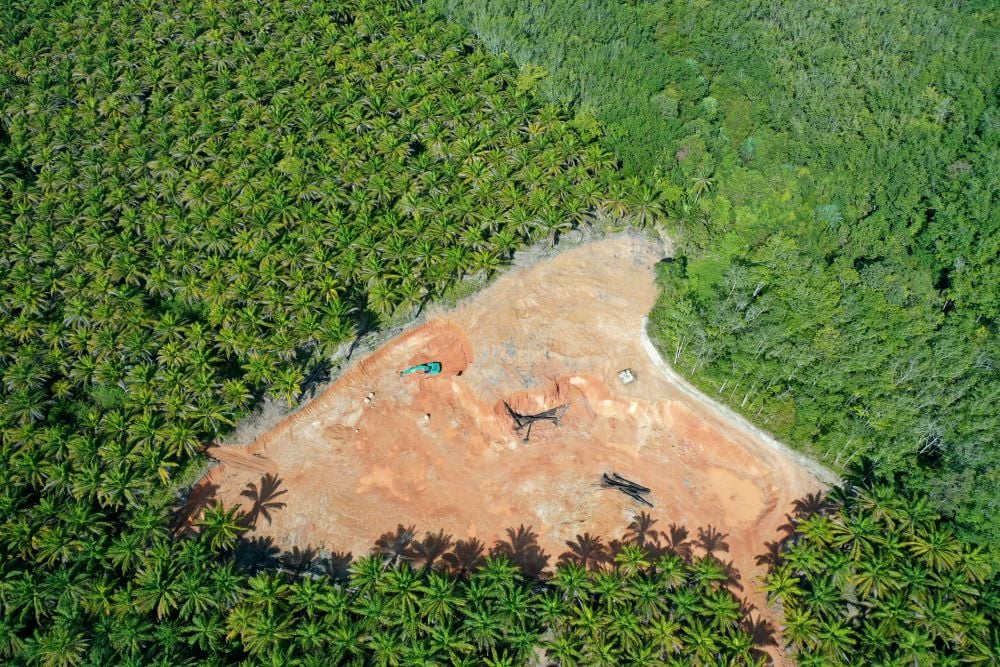Palm oil is a highly productive crop, being the most produced type of vegetable oil in the world at nearly 72 million tonnes annually . However, as productive as palm oil can be, its extraction or production contributes significantly to global forest loss and biodiversity degradation. Nearly 220 million hectares of forests, an area larger than the size of Germany, have been lost due to palm oil production since 1990.
Southeast Asia, where most palm oil is produced, houses 20% of the world’s plant, animal and marine species in its tropical forests, which also act as natural carbon sinks. As such, accelerated forest loss would not only cause up to 40% of the region’s flora and fauna to vanish by 2100, but also lead to the release of up to 2 billion tonnes of carbon dioxide (CO2) per year, contributing further to the conditions for climate change.
Fortunately, deforestation rates have been declining for the past few years due to emerging environmental regulations and new industry standards. Indonesia for instance hit a historic low in deforestation rates last year, a 75% drop from 2019. Nonetheless, experts caution that now is not the time for complacence, as post-pandemic economic recovery could jumpstart forest-clearing activity.
Palm oil production does not necessarily have to happen at the expense of the environment. Good agricultural practices and careful management can help achieve production with minimal negative environmental impact. As the world’s second-largest importer and third-largest consumer of palm oil, China has an especially crucial role to play in transforming the palm oil value chain to protect Asia’s forests.
Why China is key in the battle against palm oil forest loss
China’s palm oil demand has been increasing throughout the years due to its use as a cooking oil and major ingredient in instant noodles, as well as application in the oleochemical sector, which includes soaps and cosmetics. In 2020, China’s total palm oil related product imports reached 7.2 million metric tons – but only a single-figure percentage were certified as sourced or produced from sustainable palm oil.
That being said, China’s high-level domestic commitments and policies in recent years clearly signal its resolution and efforts to take the lead in addressing climate change and biodiversity issues. In May 2018, the Chinese government proposed six principles for upholding ecological civilization to reiterate the importance of natural environment including forests, and the necessity of regulations to protect them.
Meanwhile, various green finance policies, laws and guidelines have been launched to mobilize financial support for low-carbon, greener and more sustainable industries. Additionally, government efforts in greening the Belt and Road Initiative to align with local climate actions and Sustainable Development Goals also lean towards a stricter regulatory context for Chinese overseas investment.
With enhanced regulatory scrutiny of agricultural commodity supply chains, coupled with changes in end-consumer and buyer preferences in favour of sustainably produced palm oil, as well as emerging physical risks from climate change, companies that continue to produce and/or source unsustainable palm oil are becoming a great liability for lenders and investors.
A new report by CDP found an estimated US$5.1 billion in loans and underwriting services provided by Chinese financial institutions to companies most exposed to forest-related risk in China’s palm oil supply chain. This exposure leaves the financial sector vulnerable to underlying risks in the form of non-performing loans, reduced value of collateral, lower solvency rations and slimmer profit margins.
Credit in China’s palm oil sector is highly concentrated among a select group of financial actors, which further increases their exposure to forest-related risk. The top 15 creditors combined account for more than 85% of loans and underwriting services. Five of China’s state-owned financial institutions were the biggest lenders, each providing more than US$100 million in loans over the period from 2013 to 2020.
Moving beyond reactive compliance to proactive engagement
CDP’s research points to an urgent need for capital in China to be shifted away from companies with unsustainable practices to those who are building more sustainable systems. The significant influence of Chinese financial actors across the palm oil supply chain presents a unique opportunity for the sector to catalyze the shift towards sustainability by engaging with the companies they lend to, invest in and insure.
Although most Chinese financial institutions acknowledge that ESG risks are becoming the focus of their internal sustainable finance policies, such efforts currently tend to focus on compliance with national environmental regulations and green finance policies. Chinese financial institutions are government-policy oriented and hesitant to take more comprehensive measures before being required to do so.
Nonetheless, more forceful policies and measures are expected in the coming years, driven by the Chinese government’s pledge to achieve peak carbon emissions by 2030 and achieve net-zero emissions by 2060. Therefore, there is a building case for anticipating such measures to achieve best practices in line with international peers, rather than playing catch-up when regulations finally come into effect.
Chinese financial institutions can now look to an increasing number of high-profile initiatives by international peers as examples of best practice. Not only have these financial institutions implemented robust due diligence procedures, but they have gone much further by proactively engaging with their clients and investees to ensure compliance with all their sustainability-related policies.
For instance, BNP Paribas’ Palm Oil Sector Policy expresses full support for sustainable palm oil and urges companies to adopt No Deforestation, No Development on Peatland, and No Exploitation policies. The bank sets out specific criteria for palm-oil related companies as part of its due diligence process, which must be met without exception before it considers providing financial products and services.
Meanwhile, asset manager Robeco became a member of the Roundtable on Sustainable Palm Oil (RSPO) in 2019 and excludes companies that have less than 20% of their operations RSPO-certified from its investment universe. Companies with 20% to 80% certification are subject to an enhanced engagement trajectory, which gives them until December 2021 to achieve at least 50% certification of their operations.
Greater transparency needed for environmental risk management
Last year, a total of 687 global companies disclosed their data to CDP Forests, of which 187 disclosed details of forest-related risks in the production and/or sourcing of palm oil commodities. Two-thirds of these companies identified forest-related risks in their businesses, and collectively reported potential underlying financial impacts valued at a staggering US$13.2 billion.
Since most of any financial institutions’ environmental risks come from its portfolio, it is thus imperative for Chinese financial institutions to start formulating systematic and transparent sustainability criteria to effectively identify and manage their exposure to ESG risks, including those specifically related to forests, through their financing of companies active in palm oil value chains.
Forest loss has for too long been overlooked in business reporting, with just 40 companies in China reporting on forests to CDP in 2020, up from 21 in 2019. Despite growing awareness, current levels of transparency among Chinese financial institutions involved in the palm oil supply chain are far below minimum requirements for any degree of environmental risk management.
As the market shifts and the climate crisis intensifies in the upcoming years, the time is now for full value-chain transformation to protect Asia’s vital forests. China’s financial sector is in a powerful position to lead the way, starting with robust, timely and actionable disclosures as a key first step.
Fei Li is an associate director of CDP China.









